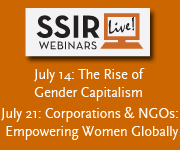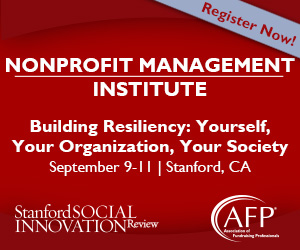The Nonprofits of 2025
One of 16 special essays on how the field of social innovation has evolved and what challenges remain ahead.
10th Anniversary Essays
Sixteen special essays on how the field of social innovation has evolved and what challenges remain ahead.
-
Celebrating Ten Years
-
The Globalization of Giving
-
Design-Led Innovation in Government
-
Out of London and New York
-
The Nonprofits of 2025
-
Money Is Never Enough
-
Standing with the Poor
-
Reshaping U.S. Public Education Policy
-
Fifty Years of Social Change
-
Consumer Rising: From Consumption to Production to Design
-
The Mobile Continent
-
Toward an Open-Solution Society
-
A Team of Teams World
-
Jobs and Social Innovation
-
The Empowerment of Arab Women
-
The Trouble with Winning
Like all institutions and organizations, nonprofits are shaped by political frameworks, policies, and programs. So if we ask what future nonprofits might look like—say, the nonprofits of 2025—we must review past and current trends. For several decades, most developed market economies have seen a general increase in the economic importance of nonprofit organizations as providers of health, social, educational, and cultural services. There also has been a new and renewed emphasis on the social and political roles of nonprofits, usually in the context of civil society, democracy building, and political participation. Indeed, these developments are taking place in many countries, and they are driven in large measure by four broad perspectives.
First, nonprofits are increasingly part of new public management (NPM) approaches—what could be called a mixed economy of welfare—with a heavy reliance on quasi-markets and competitive bidding processes. Examples of this development include expanded contracting regimes in health and social service provision, voucher programs of many kinds, and public-private partnerships. In essence, this policy choice treats nonprofits as more efficient providers than public agencies and as more trustworthy than for-profit businesses in markets where monitoring is costly and profiteering likely.
Second, nonprofits are seen as central to building and rebuilding civil society and strengthening the nexus between social capital and economic development. With the social fabric changing, civic associations of many kinds seem to be the glue holding diverse societies together. The basic assumption is that people embedded in dense networks of associational bonds are not only less prone to social problems but also economically more productive and politically more involved.
Third, nonprofits are crucial to social accountability. They are increasingly viewed as instruments of greater transparency and heightened accountability for improving governance of public institutions and businesses. Accountability mechanisms include citizen advisory boards, community councils, participatory budgeting, public expenditure tracking, monitoring of public service delivery, and consumer protection. The underlying premise is that conventional accountability enforcement mechanisms such as elections, public oversight agencies, and the media are falling short; nonprofits are to become the social whistleblowers and advocates for voices that would otherwise remain unheard.
For several decades, most developed market economies have seen an increase in the economic importance of nonprofit organizations as providers of health, social, educational, and cultural services.
Fourth, nonprofits are seen as a source of innovation in solving social problems. Indeed, nonprofits are assumed to be better at social innovations than governments, because their smaller scale and greater proximity to communities make them creative agents in finding solutions. Governments are encouraged to seek a new form of partnership with nonprofits aimed at identifying, vetting, and scaling up social innovations to build more flexible, less entrenched public responses.
What do these perspectives mean for the nonprofit sector of the future? Assuming that the trends continue, the following scenarios may serve as markers that nonprofit representatives may wish to consider:
NPM Scenario | Nonprofits become a set of well organized, quasi-corporate entities that take on the tasks and functions that previously were the purview of the state, but that are now delivered through competitive bidding processes and contractual arrangements, to maximize the competitive advantages of nonprofit providers in complex social markets. In the end, the nonprofit sector could become the private extension agent of a minimalist contract regime run by government.
Civic Scenario | Nonprofits are the building blocks of a self-organizing and self-correcting community corpus. They are part of a benign civil society in which high levels of individualism and special interest coincide with equally high levels of participation, engagement, and connectivity. The nonprofit sector would form a set of interlocking associational complexes that prevent social ills and detect and correct them before they become “social problems.” Largely the self-governing bedrock of civil society, and supported by philanthropy, nonprofits coordinate their own activities and exist at arm’s length alongside a small, technocratic state.
Accountability Scenario | Nonprofits are a force of and for advocacy. As a source of dissent, and with independent philanthropic resources at their disposal, they challenge and protect—by building and moving political agendas and monitoring government and business. Indeed, they emerge as a countervailing force that serves as a social, cultural, and political watchdog keeping both market and state in check and accountable. The nonprofit sector creates and reflects the diversity, pluralism, and dynamism of modern society.
Innovation Scenario | Nonprofits are encouraged to operate in problem fields that politicians find either too costly or inopportune to tackle themselves. Elected leaders can contend that “something is being done.” Nonprofits are the fig leaf for a political world unwilling to tackle social problems in a serious way. Attracting philanthropic venture capital, and integrated into social investment markets, nonprofits become the “search engine” for social problem solving in modern societies.
It is, of course, unlikely that any of the four scenarios will prevail exclusively; more likely, one may become dominant, especially economically. In this respect, the NPM scenario will continue to shape the evolution of service-providing nonprofits. It will enable new for-profit/nonprofit hybrids to emerge, not only in the changing health and social care markets but also in fields where public contracting will become more prominent: education and research, environment, energy, and information technology.
The various scenarios outlined above not only cast the nonprofit sector in a different role, they also imply different roles for the state and business. At one level, nonprofits become parallel actors that may complement or even counteract state activities and compete with businesses, as in the NPM scenario. This perspective is very much in line with classical liberalism and is also present in the civil society and accountability scenarios. At another level, the state and nonprofits are part of ever more complex public-private partnerships; they work in complementary fashion with other agencies, public and private.
Both scenarios are possible, as traditional notions of public benefit and public responsibilities shift from the state to other actors, paving the way for nonprofit organizations to be private actors for the public good. The role of the state as “enabler” and “animator” of private action for public service has increased and will continue to do so. This development, in turn, will continue to push and pull nonprofits in all the four directions—amounting, in the end, to a future positioning that is as contradictory as it is dynamic, and as unsettled as it is vital for society.


 To create a healthy society the plural sector needs to take its rightful place alongside the private and public sectors.
To create a healthy society the plural sector needs to take its rightful place alongside the private and public sectors.
 By adopting a model from business, nonprofit organizations can launch, test, and implement new programs and services more efficiently.
By adopting a model from business, nonprofit organizations can launch, test, and implement new programs and services more efficiently.  These groups' perspectives are closer than most think—and it’s good news for philanthropy.
These groups' perspectives are closer than most think—and it’s good news for philanthropy.
 Including community members in decisions about evaluation can improve the community’s capacity to effectively manage and control change.
Including community members in decisions about evaluation can improve the community’s capacity to effectively manage and control change.
 Are traditional assumptions about how we “do” philanthropy preventing us from finding new and better ways of working?
Are traditional assumptions about how we “do” philanthropy preventing us from finding new and better ways of working?
 Four ways to improve community evaluation so that it helps build, rather than erode, social progress.
Four ways to improve community evaluation so that it helps build, rather than erode, social progress.
 Three ways to create an environment where interdependent stakeholders can perform their individual roles optimally and collaborate with each other effectively.
Three ways to create an environment where interdependent stakeholders can perform their individual roles optimally and collaborate with each other effectively.
 Why we must leverage hands-on experience and service learning to encourage the next generation of social innovators.
Why we must leverage hands-on experience and service learning to encourage the next generation of social innovators.
 If we want the nonprofit sector to innovate, we need to acknowledge the gender gap between nonprofits and the private sector.
If we want the nonprofit sector to innovate, we need to acknowledge the gender gap between nonprofits and the private sector.




COMMENTS
BY David Crowley
ON March 7, 2013 02:51 AM
Thanks for a though-provoking article. We at Social Capital Inc. work in the US to foster increased social capital and civic engagement. Thus, we see the importance of the elements of your “civic scenario”. I would say, at least in the US, the nonprofit sector as a whole could do more to be a source of social capital rich associations. Some such as Theda Skocpol have argued the professionalization of the nonprofit sector limits the extent to which associations serve as a training ground for democratic participation. In our work and in our blog, we seek to identify ways nonprofits can do more to create social capital. All that said, there a beneficial aspects to the other scenarios, too.
David Crowley, President
Social Capital Inc.